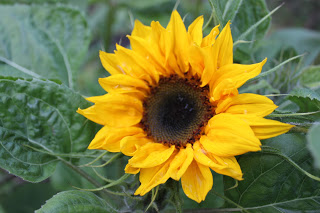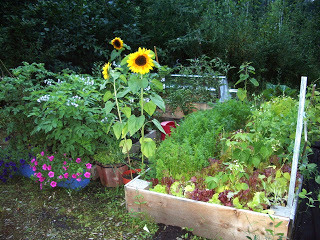A Lesson Plan for Gardening in the Classroom in Alaska, by Sabrina Silvernale, an Alaska Master Gardener
 |
| Photo by Heidi Rader. |
Subject Area: Math
Grade Level: K-3
Ideal Season for Lesson: Spring through Early Autumn
Time Needed: 20-30 min per activity
Materials Needed:
Sunflower seeds, 3 per student. Look for tall varieties, different colors
Garden space: Each student’s 1-3 seeds should be planted 12-18 inches from the next students’ 1-3 seeds)
Tools to prepare soil, shovel or trowel
Strong bamboo canes, one per student, labeled with his or her name
Plant ties
Liquid fertilizer
Watering can(s) & water
Introduction:
This experiential lesson uses gardening and science as a basis to learn and apply basic academic skills, in this case, mathematics, as it relates to measurement and organization. It is also a great activity for estimation and problem solving. Besides, it’s so much fun to grow giant, iconic flowers that produce edible seeds. Kids can try to beat the sunflower record. The tallest was over twenty feet tall! Here is an opportunity to learn new vocabulary, follow and clarify directions, and develop patience (though, thanks to these flowers, not too much). In these projects, students complete a life cycle circle. They plant a seed, help it grow, feed the plant, see a flower appear, let it fade and collect the seeds to plant again.
To Sow Seeds:
 |
| A growing sunflower. Photo by Heidi Rader. |
A week or two before the expected last frost (June 1st) place the sunflower seeds between a couple of pieces of damp paper towels to initiate germination. It is very important that your paper towels are not wet but only damp; wet paper towels will reduce your chances for successful germination.
Leave the damp paper towels and the sunflower seeds on their own for a couple of days and check on their progress from time to time; those seeds that have started to grow are ready to be planted.
At this point, the germinated seeds can be planted directly into the ground, or nurtured in pots for a week maximum prior to an outdoor planting.
Note: Sunflowers do not benefit from an extended time to get started indoors.
As soon as the soil can be dug in your area (about June 1 in Alaska) choose a sunny spot in the garden. Sunflowers are capable of growing in poor soils, but generally flourish in the soil of the average garden. Provide wind protection if possible, using a fence or wall as back-up, but realize that sunflowers enjoy full sun, which means more than 6 hours per day.
Although the sunflower enjoys water, you should not water a sunflower too much, since this will contribute to root rot and may loosen the soil to the extent that the sunflower will fall. If you wish, you can use a liquid fertilizer once every two weeks, taking care to pour the solution around the sunflower, not directly on the stem of the plant. Because tall sunflowers are vulnerable to wind damage, provide wind protection if possible, such as a fence or wall.
Each student plants three seeds together, 12-18 inches apart from other students’ seeds (consult seed package for complete directions). (If they all germinate, they choose the biggest one to keep and pull out the others. The students can take them home or give them to others.
The student pushes in a (how tall?) bamboo cane with his/her name on it next to his seeds.
Water upon planting and daily until well established. Then water at least weekly.
Growth will show in less than two weeks, thanks to the advance germination. Since plant growth will depend on warm, sunny days, maintaining annual class records may be a fun way for “graduated’ students to pay attention to successive classes’ efforts in the garden, with “award winning’ flowers listed for posterity.
As the stem grows, children tie it carefully with xyz to the cane for support.
When the backside of the sunflower heads turn yellow, watch the birds, squirrels and other animals that enjoy sunflower seeds! Once the back of the sunflowers head has turned brown it means harvest-time has arrived. Cut the head off around a foot down on the stem – once that is done all you have to do is rub the head using your hand and the seeds will fall off.
 |
| Photo by Heidi Rader. |
Follow-up Activities:
As sunflowers grow, students can engage in a number of age appropriate math and inter-disciplinary activities. Examples for math, science, language arts, and art:
Measure the stems with a variety of units (hands, inches, feet, meters).
Graph their range of flower growths on age-appropriate charts.
Based on research about the plant and the season’s weather projections, students make and refine predictions of ultimate height.
They can compare plant growth and assess causes of differences. Does this one have more sun/shade/wind?
They can keep records of how much they water, how much fertilizer they apply and compare it to a few that the teacher has planted for controlled failure — less water, fertilizer, sun, etc.
After the initial period of daily watering, weekly growth checks will provide obvious and measurable changes worth a classroom math activity.
When flower heads fade, their circumference and radius can be measured.
The number of seeds can be estimated, counted, weighed.
Research what percentage of seeds is likely to yield a second generation? How should the seeds be stored?
Research the sunflower industry. How are plants and seeds used around the world?
Develop word problems based on the math projects.
Extended Curriculum:
Other Math GLEs may be addressed such as problem solving. Students’ graphs can be used to create problem solving opportunities that incorporate number concepts, addition, subtraction, etc. For instance, the following “problems’ might apply to a class chart:
Which flower grew the tallest/shortest?
How much taller did B grow than F?
How much shorter did F grow than B?
If B stood on top of A, how tall would they be together?
Of course, any fun project can be useful for a variety of subjects. Sunflowers can be read about in science books, the Internet, children’s literature, and especially seed catalogs and packages. Vocabulary can be used to illustrate decoding strategies like phonics, context, etc. For Science, it’s an introduction to botany, rich in new vocabulary (germinate, stem, petal, cotyledon, seed, photosynthesis). Observe how the flower heads track the sun. Sunflowers are useable in arts and crafts as well as worthy subjects of art and photography. Try making a seed garland from the dried seed heads to feed the birds. Or, collect and roast the seeds for a healthy class snack, or dye yarn or fabric from the stems or flower heads.
 |
| Photo by Heidi Rader. |
Outcomes:
Alaska Standard: A student should understand mathematical facts, concepts, principles, and theories.… through the application of number theory, measurement, problem solving and data organization.
GLE: M2.1.3: The student uses measurement techniques.
M6.1.3: The student demonstrates an ability to classify and organize data
Bibliography:
Assessment, Accountability and Student Information. Alaska Department of Education and Early Development. https://www.eed.state.ak.us/tls/assessment/GLEHome.html. Aug. 3, 2011.
Buczacki, Stefan and Beverly. Young Gardener. London: Frances Lincoln Children’s Books, 2009
McCormick, Rosie. 2002. Arty Facts — Plants and Art Activities. New York: Crabtree Publishing Company.
https://www.dltk-holidays.com/fall/crafts-sunflowers.htm
https://www.sunflowernsa.com/all-about/default.asp?contentID=61
About Heidi Rader
Twitter •